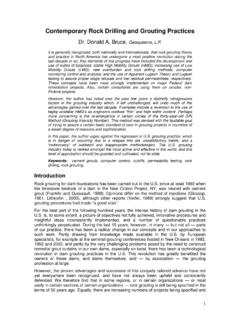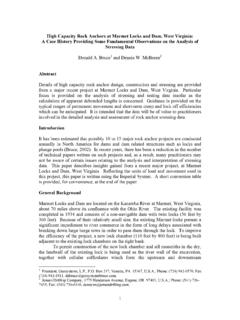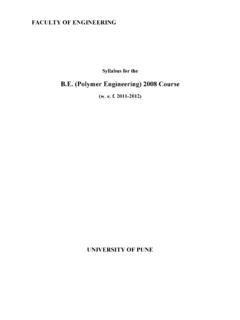Transcription of Seepage Cut-Offs for Levees and Dams - The Technology …
1 Seepage Cut-Offs FOR Levees AND dams : THE Technology review Dr. Donald A. Bruce1 Abstract Seepage through and under existing Levees and embankment dams is a major threat to such structures all across the country, and programs of unprecedented scale have been initiated to remediate this problem. The paper provides a Technology review of the various methods used to install such Cut-Offs , in both rock and soil conditions. These technologies are subdivided as follows: Category 1 Cut-Offs involve backfilling of a trench or shaft previously excavated under bentonite slurry or similar supporting medium.
2 Examples include the use of backhoes, grabs, hydromills and secant piles. Category 2 Cut-Offs involve the mixing of the fill and/or foundation soils in situ. Examples include conventional ( , vertical axis) Deep Mixing, the TRD method and CSM method. For each, the pros and cons, methodologies, applicability and budget costs are provided, as are details from recent case histories and a comprehensive bibliography. INTRODUCTION Cut-Offs to prevent Seepage and/or internal erosion are an integral part of many dam and levee remediation projects.
3 For example, Bruce et al. (2006) reported on 22 North American dams which had been remediated between 1975 and 2004 with a major cut-off of some type, while currently over half a billion dollars worth of deep concrete diaphragm walls are under contract in various major dams in the alone. Such Cut-Offs remain, of course, common features in the design and construction of new structures. Whereas attention is typically and appropriately drawn to these very high profile projects wherein the depth and complexity of the work are extraordinarily impressive, there is an equally important volume of cut-off construction associated with levee remediation.
4 For instance, the Army Corps of Engineers, together with local partners has, for almost two decades, been remediating the Levees in Sacramento, California, the work at Herbert Hoover Dike, around Lake Okeechobee in Florida, is now fully underway, while equally ambitious projects are imminent in New Orleans. Cut-Offs for Levees are typically shallower than those for dams , for obvious reasons associated with the height of the levee itself and the nature of the foundation materials: there is no call to penetrate one or two hundred feet of embankment material and then continue for another hundred feet into rock, often both hard and abrasive on the one hand, and containing massive karstic features on the other.
5 However, the engineering requirement for a levee cut-off to have acceptable permeability, strength, deformability, homogeneity, continuity and durability does present challenges to the engineering community, especially when it is borne in mind that although such Cut-Offs are typically less than 100 feet in depth, they may well extend laterally for tens of thousands of feet. _____ 1 President, Geosystems, , Box 237, Venetia, PA 15367, ; Phone (724) 942-0570; Fax: (724) 942-1911; Email: The purpose of this paper is to provide a comparative review of the various technologies which are being used, or can be foreseen to be used, to construct Cut-Offs through Levees and dams .
6 There are many ways to classify and present these technologies, and in this paper, the following simple classification has been adopted: Category 1 Cut-Offs are created by backfilling a trench or shaft excavated under a bentonite slurry or similar supporting medium. Category 2 Cut-Offs are created by mixing the fill and/or foundation soils in situ. Regarding Category 1, most levee cut-off work is conducted in a continuous and laterally progressive fashion by backhoe. In contrast, dam Cut-Offs are usually constructed by the panel method using clamshell and/or hydromill technologies.
7 In certain conditions typically karstic limestone the cut-off can be constructed by overlapping large diameter columns installed in a Primary-Secondary, secant fashion, or by the Arapuni method (Gillon and Bruce, 2003). The oldest method under Category 2 is the conventional Deep Mixing Method (DMM) using vertical mixing augers equipped with mixing blades. More recently, the goal of producing high quality soilcrete in situ has been addressed by two new technologies, namely the Japanese TRD (Trench Remixing and Cutting Deep) Method, and the Franco-German CSM (Cutter Soil Mix) Method and its Italian sister, CTJet.
8 CATEGORY 1 Cut-Offs (EXCAVATION AND BACKFILL) General Comment The intrinsic advantage of such walls is that the resultant cut-off material ( , the backfill ) can be engineered to provide an extremely wide range of properties, independent of the native material through which the cut-off is to be excavated. This ability is so fundamental that the actual Cut-Offs are primarily called after the materials themselves, as opposed to the method of excavation: conventional concrete walls plastic concrete walls cement-bentonite walls (CB) soil-bentonite walls (SB) soil-cement-bentonite walls (SCB) In all cases except CB walls, excavation is conducted under bentonite (or polymer) slurry which is thereafter displaced out of the trench or panel by the backfill material of choice.
9 It is generally believed that the concept of excavating under a bentonitic supporting slurry was first developed by Veder, in Austria, in 1938. The relationship between backfill material and excavation method is summarized below. TYPE OF BACKFILL EXCAVATION METHODCLAMSHELL HYDROMILL BACKHOE SECANT PILES Conventional Concrete Typical Typical Not feasible Typical Plastic Concrete Feasible Feasible Not conducted Rare CB Feasible Feasible Common Not conducted SB Not conducted Not conducted Very common Not conducted
10 SCB Very Rare Very Rare Common Not conducted Excavation Methods Details of the various excavation methods are provided in older fundamental texts such as Xanthakos (1979) and ASTM (1992), while Bruce et al. (2008) summarize case histories of more recent vintage. Much valuable information may also be obtained in the websites of the major contractors and equipment manufacturers. The following notes are provided by way of introduction, and perspective. It is often the case that all three techniques may be used on the same project: the backhoe to excavate a pre-trench, say 20-40 feet deep, the clamshell to excavate through unobstructed fill or soil, and the hydromill to cut into the underlying or adjacent rock.
















